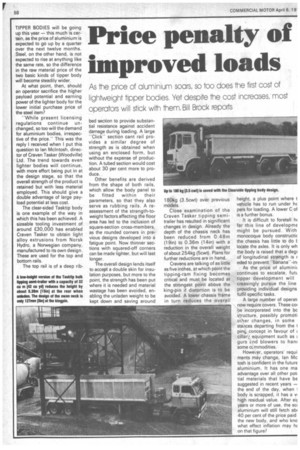Price penalty of unproved loads
Page 60

If you've noticed an error in this article please click here to report it so we can fix it.
As the price of aluminium soars, so too does e first cost of ligh-weight tipper bodies. Yet despite -ne cost increases, most operators will stick with nem. Bill Brock reports
TIPPER BODIES will be going up this year — this much is certain, as the price of aluminium is expected to go up by a quarter over the next twelve months. Steel, on the other hand, is not expected to rise at anything like the same rate, so the difference in the raw material price of the two basic kinds of tipper body will become steadily wider.
At what point, then, should an operator sacrifice the higher payload potential and earning power of the lighter body for the lower initial purchase price of the steel item?
"While present licensing regulations continue unchanged, so too will the demand for aluminium bodies, irrespective of the price." This was the reply I received when I put this question to Ian McIntosh, director of Craven Tasker (Woodville) Ltd. The trend towards even lighter bodies will continue, with more effort being put in at the design stage, so that the overall strength of the product is retained but with less material employed. This should give a double advantage of large payload potential at less cost.
The clear-sided Tasktip body is one example of the way in which this has been achieved. A sizeable tooling investment of around £30,000 has enabled Craven Tasker to obtain light alloy extrusions from Norsk Hydro, a Norwegian company, manufactured to its own design. These are used for the top and bottom rails.
The top rail is of a deep rib bed section to provide substantial resistance against accident damage during loading. A large "Click" section cant rail provides a similar degree of strength as is obtained when using an enclosed form, but without the expense of production. A tubed section would cost about 30 per cent more to produce.
Other benefits are derived from the shape of both rails, which allow the body panel to be fitted within their parameters, so that they also serve as rubbing rails. A reassessment of the strength-toweight factors affecting the floor area has led to the inclusion of square-section cross-members, as the rounded corners in previous designs developed into a fatigue point. Now thinner sections with squared-off corners can be made lighter, but will last longer.
The overall design lends itself to accept a double skin for insulation purposes, but more to the point, the strength has been put where it is needed and material wastage has been avoided, enabling the unladen weight to be kept down and saving around 180kg (3.5cwt) over previous models.
Close examination of the Craven Tasker tipping semitrailer has resulted in significant changes in design. Already the depth of the chassis neck has been reduced from 0.48m (19in) to 0.36m (14in) with a reduction in the overall weight of about 254kg (5cwt), Plans for further reductions are in hand.
Cravens are talking of as little as five inches, at which point the tipping-ram fixing becomes critical and must be located at the strongest point above the king-pin if distortion is to be avoided. A lower chassis frame in turn reduces the overall height, a plus point where t vehicle has to run under hc pets for loading. A lower C of is a further bonus.
It is difficult to foretell tit far this line of developme might be pursued. With monocoque body constructic the chassis has little to do t locate the axles. It is only wh the body is raised that a degt of longitudinal strength is r eded to prevent "banana' -ini As the price of aluminil continues to escalate, futi. tipper development will creasingiy pursue the line providing individual designs fulfil specific tasks.
A large number of operati now require covers. These col be incorporated into the be structure, possibly promoti miler changes, in some staoces departing from the 1 pi% concept in favour of t cillar; equipment such as t guts rid blowers to hant some ccrnmodities.
However, operators' requi ments may change, Ian Mc tosh is confident in the future aluminium. It has one ma advantage over all other pot hal materials that have be suggested in recent years — the end of the day, when 1 body is scrapped, it has a vi high residual value. After eic years or more of use, the sci aluminium will still fetch abt 40 per cent of the price paid the new body, and who kno what effect inflation may hz on that figure?




































































































































































